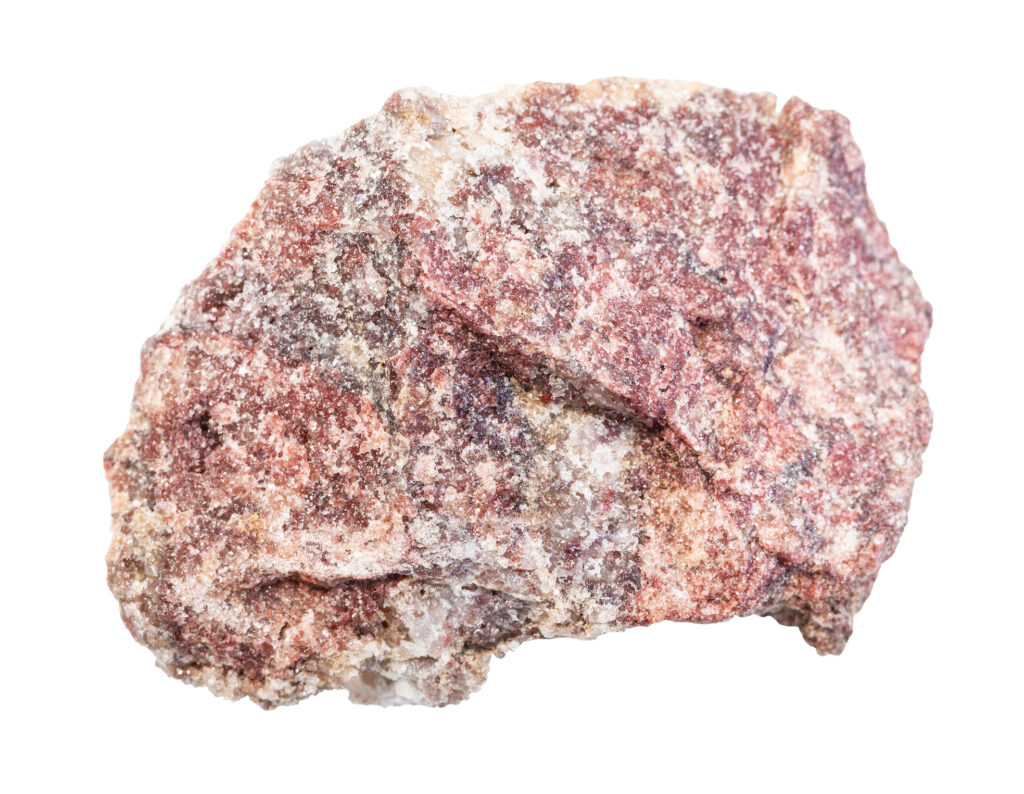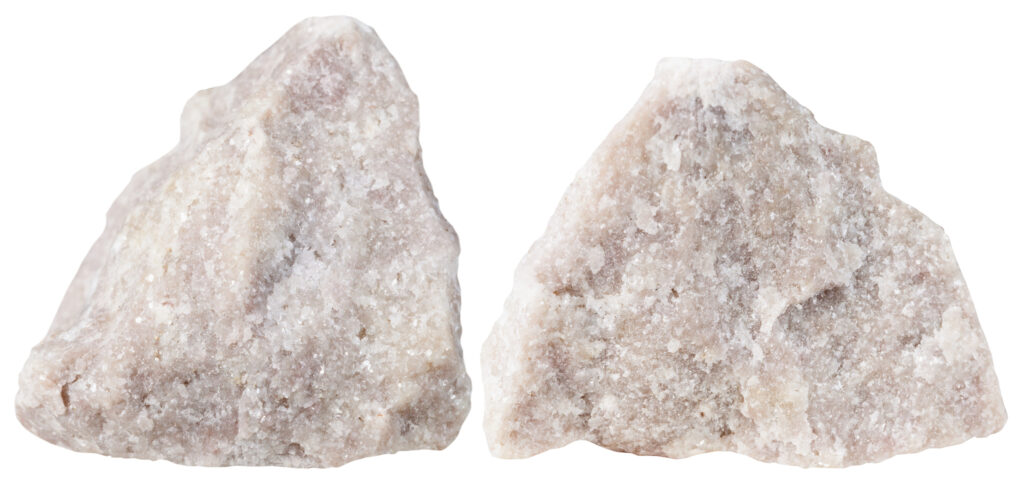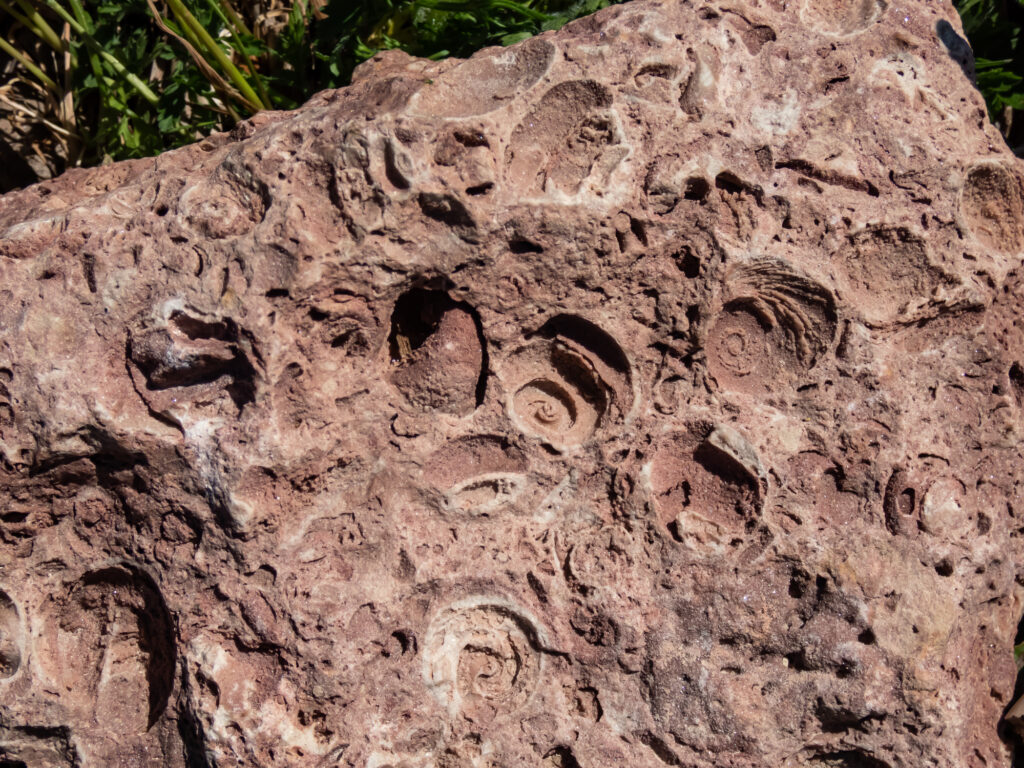Dolomite, or dolostone, is a rock that many people aren’t familiar with, even though chances are good that they have seen or even held it at some point in their lives. It is not as widespread as most other sedimentary rock types, but if you know what to look for you might discover that it is more common than you thought. I thought it would be helpful to go over what dolomite is and how to go about identifying it.
Dolomite, or dolostone, is a carbonate sedimentary rock made mostly from the mineral dolomite, CaMg(CO3)2. It commonly occurs in association with limestone and shares many of the same properties, but reacts only weakly with acid. Dolomite often has a sugary texture and is typically off-white to gray in color.
It is important to understand that dolomite rock shares a name with the mineral dolomite, from which it is almost entirely made. The rock dolomite is sometimes referred to as dolostone or ‘dolomite rock’ to avoid confusing the two, but simple ‘dolomite’ remains the most-used term.
While dolomite is a clearly defined rock type, it can still be difficult to know whether a rock you’ve found is actually dolomite. It can easily be confused for similar, closely related rocks – especially limestone. I’ll walk you through how to identify dolomite, what different varieties look like, and where it can be found.
What Does Dolomite Look Like?
One of the reasons it can be so difficult to identify dolomite is how closely it resembles limestone. This similarity is because dolomite forms from the chemical alteration of limestone in a process called dolomitization.
Sometimes a rock can even be a mixture of limestone and dolomite, making it almost impossible to confidently label it. Sometimes the only way to tell the difference between the two is to run some simple tests. But, thankfully, you can usually visually identify dolomite just by looking at it if you know what to look for.
Dolomite is usually off-white to gray in color, but may also have tinges of yellow, brown, green, or pink. Its texture is often sugary and granular, with more well-developed crystal grains than those of limestone. Fossils such as shells are common, sometimes with crystal grains growing through their outline.

While all dolomite fits this general description, there is still quite a bit of variability from location to location. This variability is mostly due to the mineral makeup (including impurities) of the dolomite and the texture of the rock. Thankfully, there isn’t as much variability in dolomite as there can be in limestone, which makes it somewhat easier to identify than could be the case.
Pro Tip: I have created the best rock identification system you’ll find anywhere. It’s made to help everyone from brand new hobbyists to university Geology students, and includes an eBook, digital tools, a video tutorials. Find out more here!
Color is Driven by Mineralogy
Dolomite is generally a very ‘pure’ rock in the sense that it is almost entirely comprised of magnesium-calcium carbonate (the mineral dolomite). This, in turn, means that almost all dolomite you encounter will be whitish or off-white. However, there are some common impurities that can have a significant impact on the color of dolomite if they are present in high enough quantities.
Manganese and iron are both fairly common impurities that can give dolomite a yellowish, pink, or even rust-red color. While not common, dolomite can sometimes be dark gray or even black if it contains enough organic material.
Sometimes you’ll find a piece of dolomite that appears to be streaked with different colors. This is usually from iron, manganese, or magnesium staining the rock after it has already been formed. Water, laden with these minerals, seeps through the dolomite and stains the white dolomite in different colors, depending on what minerals are present at the time.
Pro Tip: To get a better look at the crystals in your rocks and help with identification I highly recommend picking up a good geologist’s hand lens. I use this one that I got on Amazon.
Texture of Dolomite
As I briefly mentioned above, the texture of dolomite is usually granular or even sugary. This is due to the relatively well-developed crystals, especially when compared to most limestones. Individual crystal grains are usually visible to the naked eye and are often well-organized and rhombohedral in shape.
Dolomite is often fossiliferous, containing many fossilized shells or coral fragments. These fossils are sometimes almost perfectly preserved, but other times they look almost ‘hazy’ because their outlines have been blurred by recrystallization.
How to Identify Dolomite
By now you might be thinking that identifying dolomite must be incredibly difficult, especially with how closely it can resemble limestone. Often the identification process comes down to identifying the rock as being either limestone or dolomite and then attempting to distinguish between the two through a few simple physical tests.
To identify dolomite, first look for its characteristic white, off-white, or light gray color. It is relatively soft and can be scratched with a penny, but will usually scratch your fingernail. Unlike limestone, dolomite reacts only weakly with an acid solution. Fossils, shell fragments, and coral are common.
In general, the physical tests you use to identify dolomite are the same as for limestone. These tests are designed to give an indication of the mineralogy of the rock, and in the case of dolomite (or dolostone), we are testing for the presence (and abundance) of the mineral dolomite.
One of the best identifying features of dolomite is its hardness. Since it is almost entirely made of the mineral dolomite, the rock has a very similar hardness of around 3.5 to 4 on the Mohs hardness scale. This is slightly harder than pure limestone, and can sometimes be used to help distinguish between the two.
Dolomite can be scratched with a steel knife, but is about the same hardness as a penny. A knife will leave scratches on the surface of both dolomite and limestone. A penny will leave a scratch on the surface of limestone, but most of the time won’t leave one on dolomite. Both rock types will leave a scratch if you rub a sharp point on your fingernail.
Perhaps the most diagnostic method for identifying dolomite is an acid test. I go into detail about how to safely perform this test with common white vinegar in my Practical Rock Identification System. Dolomite will react weakly to a diluted hydrochloric acid solution, but only if you scratch or powder it first. This reaction is a great way to tell the difference between dolomite and limestone, which only reacts strongly to acid. Always remember to use proper protective gear and take necessary precautions when handling any acid.
The presence of fossils (especially marine fossils like shells and coral) is a great indication that you’ve found dolomite. Fossils are also present in other types of sedimentary rocks like sandstone and shale, but are most prevalent in limestone.
In summary, a rock must meet all of these requirements to be considered dolomite:
- Biochemical or Biochemical Sedimentary – Formed from the hard remains of marine animals and/or the precipitation of calcium carbonate out of water
- Very Fine- to Coarse-grained – Individual grains can be almost any size, ranging in size from microscopic to over 2 mm
- Reacts with Acid – Reacts weakly with acid solution, and only when first powdered or scratched

If your rock meets all of those criteria then it is very likely dolomite, or at least something very closely related. There are a few closely related rock types that you might confuse for dolomite, so it helps to know what they are and how they differ.
- Dolomitic Marble – Metamorphosed dolomite, with larger and more organized dolomite crystals than normal dolomite.
- Limestone – Very similar to dolomite, but made of calcite instead of dolomite. Slightly softer and reacts more vigorously with acid
- Dolomitic Limestone – A mixture of dolomite and limestone, often occurs when limestone has only partially undergone the dolomitization process
What Is Dolomite Made Of?
We have already seemingly answered this question earlier in this article. Dolomite is made of calcium-magnesium carbonate – the mineral that also goes by the name of dolomite. But the real answer can be a little more involved than that. So, what exactly is dolomite made of?
Dolomite rock (or dolostone) is, by definition, made of over 50% calcium-magnesium carbonate (the mineral dolomite), usually in the form of well-defined crystals. Some calcite is also possible as a remnant of the dolomite’s precursor, limestone. Fossils are common in dolomite, especially sea shells and coral.
Dolomite is, by definition, mostly made up of calcium-magnesium carbonate. If calcite is still the dominant mineral in the carbonate rock then it would still be classified as limestone or dolomitic limestone. This ratio is almost impossible to determine without sophisticated lab testing, but luckily carbonate rocks tend to be almost entirely dolomite or limestone, with heavy mixtures of the two being fairly rare.
Tip: This article is part of my sedimentary rock identification series. To read more about how to identify all igneous rocks, check out my article here.
One of the defining features of carbonates, including dolomite, is what they’re not made from. Most clastic sedimentary rocks have some mixture of sand, silt, and clay-sized particles. But with dolomite, this usually isn’t the case.
The fossils that are so often found in dolomite rock are made of the same material the rest of the rock is made from – the mineral dolomite. These shells are the hard remains of marine life that stick around long after the animal has died, and often help to form the fabric of limestone layers. Sometimes the fossils remain as calcite longer than the rest of the rock, so you will have a dolomite rock containing calcite fossils.
Where Is Dolomite Found?
You might be wondering where you can find a piece of dolomite for yourself. Or maybe you’ve already found a rock that you think might be dolomite and you’re wondering if your area actually has any to be found.
Fortunately, dolomite is a pretty common and prolific rock type. There are carbonate outcrops all over the world, and chances are you can find some near you.
In general, dolomite is found in areas with a geologic history of rich marine life in warm, shallow marine environments such as tropical and subtropical reefs. It is often interbedded with limestone. Older carbonates are more likely to be dolomite because they have had ample time to undergo dolomitization.
Because dolomite forms almost exclusively from the alternation of limestone, it makes complete sense that it is found in the same general settings and locations as limestone.
Most limestone is thought to have been produced primarily as a byproduct of the remains of living things (biochemical). So, naturally, one of the prerequisites for the formation of most limestone is the presence of enough fossil material. The organisms from which the detritus originate are most abundant in warm, tropical or subtropical waters, so it is only natural that limestone is most common near these warm locations.
Dolomite is pretty common to find in outcrop. This is because it tends to be more resistant to weathing than most other sedimentary rocks – even moreso than limestone. Dolomite is famous for its karst topography, which is essentially a very erratic and weathered surface marked by many cracks and joints.
You can look for dolomite formations near you using this excellent interactive map from the USGS. I have a video about how to use this tool in my Practical Rock Identification System, plus even more information on how to identify limestone and other rocks.

How Does Dolomite Form?
We’ve learned all about what dolomite looks like, what it is composed of, and generally where it’s found, but I have only briefly touched on how it’s actually formed. The creation of dolomite is a fairly unique process, especially when compared to other sedimentary rocks.
Dolomite is formed when the calcium in limestone is gradually replaced by magnesium. Magnesium-bearing water filters through limestone and replaces about half of the calcium in limestone, turning it into calcium-magnesium carbonate (the mineral dolomite). This process, called dolomitization, is still poorly understood.
To completely understand how dolomite (or dolostone) is formed, you must understand that of its predecessor, limestone.
When shellfish and coral die, they leave behind their hard remains. In warm, tropical settings, these remains accumulate in large amounts. Sometimes this is in the form of coral reefs or something as simple as mounds of mud, but it has changed over geologic time.
Limestone sometimes forms almost entirely without the aid of living organisms. This type of limestone is a chemical sedimentary rock (as opposed to biochemical). It forms because ocean water is oversaturated with calcium, and in the right settings that calcium precipitates out of the water to form calcium carbonate. Warm, shallow water where this process is mostly likely to occur because the conditions are just right.
These types of marine limestones are then subjected to the normal process of diagenesis, which is the process sediments are turned into rocks. They are gradually buried by new sediment, compacted by the weight of the sediment and water above them, and then gradually cemented together by the minerals present in circulating water.
Another, more distinct method by which limestone forms is precipitation in evaporite depositional environments. This simply means that calcium-laden water is exposed on the surface in places like caves and hot springs, and when the water evaporates away the calcium is left behind. The slow accumulation of that calcium forms limestone varieties like travertine and tufa. You are likely familiar with stalactites and stalagmites, which are made of travertine.
Once the limestone has been formed, it sometimes undergoes dolomitization. Some scientists think that dolomitization can also occur before limestone is completely solidified. Dolomitization and the conditions under which it occurs are still not completely understood, but there are some generally agreed upon principles.
Water that is rich in magnesium slowly filters through the empty pore space in limestone. This allows for a chemical reaction to occur that substitutes one of the calcium atoms in calcium carbonate for a magnesium atom. The result is calcium-magnesium carbonate, with a nearly 50:50 ratio of calcium to magnesium in the rock. Put more succinctly, calcite is turned into the mineral dolomite.
It has been inferred that since it is rare to find a carbonate rock that isn’t purely limestone or purely dolomite that once the dolomitization process begins, it is a fairly rapid process. If it took many millions of years to accomplish then it would be more common to find carbonate rocks in the in-between stage where both calcite and dolomite are present in roughly equal amounts in the same layer of rock.
What Is Dolomite Used For?
Dolomite, like limestone is one of the most widely used rock types around the world. It has many practical applications, and since it is so common and widespread it has been used by cultures everywhere for a variety of purposes.
In general, dolomite is used extensively for construction in the form of building stones, aggregate material, cement mixing, and chalk. It is very popular as an artistic medium, especially in the form of dolomitic marble. Dolomites have great economic value as oil and gas reservoirs due to their high porosity.
Dolomite is so popular as a building material because it is easy to cut to desired dimensions, and is relatively soft while still being durable. In modern times, however, many dolomite-covered buildings have seen extensive damage due to acid rain which gradually eats away at the rock.
As a geologist working in oil and gas, I have overseen the drilling of many wells targeting dolomite formations. Dolomite can be extremely porous and can make for very attractive targets not only for oil wells but also for fresh drinking water.
This article is part of my rock identification series. To learn more about identifying rocks, check out my full in-depth guide here.
